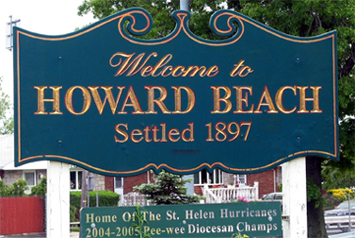From Queens: The Brand Residents Don't Buy
Back to History of Immigration
History of Howard Beach
According to the Howard Beach community website, www.howardbeach.com, this area is a neighborhood in Southern Queens with a population of 28,121 residents. This almost entirely white neighborhood stands in stark contrast to the rest of Queens, the most diverse borough of New York. Almost half of the population is Italian or of Italian descent. There is also a fairly large Jewish population among the residents. Amidst the overwhelming amount of Italians, there are small groups of Irish, German, Polish, Russian, Greek, Romanian, Austrian, French, Swedish, Scottish, and Lithuanian people. However, these nationalities make up a very small portion of the people living there. The population of Howard Beach is 85% white. The other 15% is comprised of mainly Hispanics with a lesser amount of African Americans.
The community website also gives information on the history of the area. Apparently, the settlement of the area can be traced back to two major occurrences: the construction of the Long Island Railroad and the development of the area by William J. Howard. These two events converged in the late 1890’s. Fishermen and people who enjoyed the area in the summer were already there when Howard came along and began to develop the land.
Beyond the ethnic and racial population that makes Howard Beach stand out from the rest of New York, there is also the nature of the neighborhood itself. Howard Beach is an incredibly suburban neighborhood with no apartments, high rises, or any buildings of that sort. The people living in the area don’t move either- once they’re in, they’re there to stay according to a New York Times real estate article titled "Prices Aren’t Supersonic; the Planes Aren’t Either."
The neighborhood has the reputation of being hostile to minority residents. Newspaper reports even called the boundary lines of the neighborhood “walls” to keep out all non-whites. In a sense, Howard Beach was its own secluded community in a bubble that was closed off from the rest of New York City and its diversity.
As reported in a Queens Tribune article titled "Racism Comes Home:The Howard Beach Case," the unusual instance of maintained segregation came to a head twice in both 1986 and 2007. In 1986, three African-American men were attacked while visiting Howard Beach. One of the men died. In 2007, another major confrontation occurred, this time between a large group of African Americans and Hispanics and a few white teenagers. These two instances put the neighborhood under scrutiny by the rest of the more integrated, culturally-relaxed city.
On our walking tour through Howard Beach, we observed that it is mainly, though not exclusively, comprised of a “white” population and has an ambiance related to suburbia. A number of residents had boats parked in their driveways showing the residents’ affinity for sailing. Cross Bay Boulevard was the single major venue for food, transportation and other resources. Chain franchises like Starbuck’s Coffee, Gino’s Pizzeria (fantastic pizza by the way), and Gold’s Gym on Cross Bay Blvd are located next to local commercial businesses like 99 Cents stores, El Punto Rojo, and Dr. Jay’s on Hillside and Jamaica Avenues. Today, although still overwhelmingly white, Howard Beach is more tolerant, at least according to the residents there.
Sources:
The Howard Beach Community Website An Article from The Queens Tribune An Informational Piece on Queens The New York Times Real Estate Section A New York Times Article
To learn about how Queens is being branded, click next.

